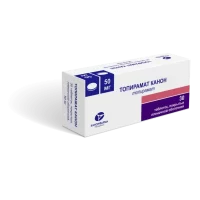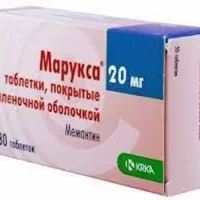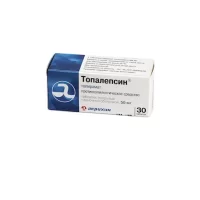Description
Valdoxan Pharmacodynamics
Agomelatine is a melatoninergic MT1 and MT2 receptor agonist and a serotonin 5-NT2C receptor antagonist.
Agomelatine is an antidepressant active in validated models of depression (acquired helplessness test, despair test, moderate chronic stress) as well as in models with desynchronization of circadian rhythms and in experimental situations of anxiety and stress. Agomelatine has not been shown to affect monoamine uptake and has no affinity for alpha-, beta-adrenergic, histaminergic, cholinergic, dopaminergic, and benzodiazepine receptors. Agomelatine enhances the release of dopamine and norepinephrine, particularly in the prefrontal cortex, and does not affect the concentration of extracellular serotonin. In experiments on animals with desynchronization of circadian rhythms it was shown that agomelatine restores synchronization of circadian rhythms by stimulation of melatonin receptors.
Agomelatine promotes the restoration of normal sleep patterns, a decrease in body temperature and melatonin release. Short-term use of agomelatine (therapy for 6-8 weeks) in doses of 25-50 mg has been shown to be effective in patients with major depressive episodes. Agomelatine has also been shown to be effective in patients with more severe forms of depressive disorder (Hamilton Scale score > 25).
Agomelatine was also effective in initially high levels of anxiety, as well as in combinations of anxiety and depressive disorders. The maintenance antidepressant effect of agomelatine (at a study duration of 6 months) at a dose of 25-50 mg once daily was confirmed. The results of the study confirmed the antidepressant efficacy of agomelatine, as assessed by time to relapse (p = 0.0001). The relapse rate was 22% in the agomelatine group and 47% in the placebo group.
The efficacy of agomelatine was demonstrated in six of seven clinical trials (advantage (2 trials), or comparable efficacy (4 trials)) in heterogeneous adult patient populations with depression, compared with SSRIs/ SSRIs (sertraline, escitalopram, fluoxetine, venlafaxine, or duloxetine). The antidepressant effect was assessed using the Hamilton scale (17-item version) as either the primary or secondary endpoint.
Agomelatine has no adverse effect on attention or memory; in depressed patients, agomelatine at a dose of 25 mg increases the duration of the slow sleep phase without altering the number or duration of the fast sleep phases. Agomelatine at a dose of 25 mg also promotes faster onset of sleep with a decrease in heart rate and improved quality of sleep (from the first week of treatment); no daytime retardation is noted. Against the background of agomelatine there is a tendency to reduce the frequency of sexual dysfunction (effect on arousal and orgasm).
Taking agomelatine has no effect on heart rate and blood pressure, does not cause sexual disorders, does not cause “withdrawal” syndrome (even if treatment is stopped abruptly) and “addiction” syndrome.
The efficacy of agomelatine at a dose of 25-50 mg once daily has been confirmed in elderly depressed patients younger than 75 years in an 8-week clinical trial. There is no confirmed evidence of a significant effect in patients 75 years of age or older. Tolerability of agomelatine in elderly patients is comparable to that in younger patients. In a 3-week, controlled trial involving patients with major depressive disorder with insufficient therapeutic effect from paroxetine (SSRIs) or venlafaxine (VINs), a withdrawal syndrome was observed when switching from therapy with these antidepressants to agomelatine treatment. Withdrawal syndromes occurred both after discontinuation of prior SSRIs/ SSRIs and during gradual withdrawal, which may have been mistaken for the low efficacy of agomelatine at the start of treatment.
The number of patients who experienced at least one symptom associated with withdrawal after one week of SSRI/ SSRI withdrawal was lower in the group with prolonged dose reduction (gradual dose reduction over 2 weeks) than in the group with rapid dose reduction (gradual dose reduction over 1 week) and than in the group with one-step withdrawal: 56.1%, 62.6% and 79.8% of patients respectively.
Indications
Treatment of major depressive disorder in adults
Contraindications
– Hypersensitivity to agomelatine and/or any of the excipients of the drug (see section “Composition”).
– Liver failure (e.g., cirrhosis or liver disease in the active phase) or increased transaminase levels by more than 3 times the upper limit of normal (see sections “Dosage and administration” and “Special indications”).
– Concomitant use of potent CYP1A2 isoenzyme inhibitors (such as fluvoxamine, ciprofloxacin) (see section “Interaction with other medicinal products and other forms of interaction”).
– Childhood under 18 years of age (due to insufficient experience in clinical use). In children and adolescents, suicidal behavior (suicide attempts and suicidal thoughts) and hostility (mainly aggression, conflict behavior, irritation) were observed more frequently in comparison with the placebo group during treatment with other antidepressants.
The drug should not be used in patients with lactose intolerance: lactase deficiency, galactosemia and glucose-galactose malabsorption.
PRECAUTIONS FOR USE
Patients with moderate to severe renal impairment when treating major depressive episodes, when concomitant administration of agomelatine with moderate CYP1A2 isoenzyme inhibitors (such as propranolol, enoxacin), patients with a history of manic or hypomanic episodes, patients with a history of events involving suicide, and patients who had suicidal intentions before therapy.
Caution should be exercised when prescribing the drug to patients who abuse alcohol or take drugs that may cause liver dysfunction.
ADMINISTRATION DURING PREGNANCY AND BREAST FEEDING
Pregnancy
There are no or limited data on the use of agomelatine during pregnancy (fewer than 300 pregnancy outcomes).
Animal studies have found no direct or indirect harmful effects on pregnancy, embryonic and fetal development, labor, and postnatal development.
As a precautionary measure, it is recommended that Valdoxan be avoided during pregnancy.
Breastfeeding
It is not known whether agomelatine penetrates into breast milk in women during lactation.
In animal experiments, agomelatine and its metabolites have been shown to penetrate into breast milk. A risk to the newborn/infant cannot be ruled out.
The relevance of breastfeeding to the infant and therapy to the mother should be evaluated and a decision should be made to discontinue breastfeeding or to discontinue the drug.
Fertility
Reproductive studies in rats and rabbits have shown no effect of agomelatine on fertility.
How to use and dosages.
- Inside. Valdoxan tablets may be taken regardless of meals. The tablet should be swallowed without chewing.
- If a new dose of Valdoxan is missed, the next dose should be taken in the usual dose (do not take the missed dose).
- A calendar is imprinted on the blister containing the tablets to help the patient monitor their intake.
- The recommended daily dose is 25 mg (1 tablet) once before bedtime. In the absence of clinical dynamics after 2 weeks of treatment, the dose may be increased to 50 mg (2 tablets of 25 mg) once before bedtime.
- The decision to increase the dose should be made taking into account the increasing risk of increased transaminase levels. Any dose increase to 50 mg should be made on the basis of a patient-specific benefit-risk assessment and with strict monitoring of liver function tests.
- Liver function tests should be performed in all patients before initiating therapy. Therapy should not be started in patients with transaminase levels more than 3 times the upper limit of normal (see sections “Contraindications” and “Special indications”). During the treatment period, liver function should be monitored periodically after about 3 weeks, after about 6 weeks (end of treatment stopping period), after about 12 weeks and after 24 weeks (end of maintenance period) after the therapy start and further as per the clinical situation (see sect. “Indications”). If transaminase activity is more than 3 times the upper limit of normal, the drug should be discontinued (see sections “Contraindications” and “Special indications”).
- If the dose is increased, liver function should be monitored with the same frequency as in the beginning of the drug administration.
Duration of treatment - Drug therapy for depression should be carried out for at least 6 months until the symptoms of depression have completely disappeared.





